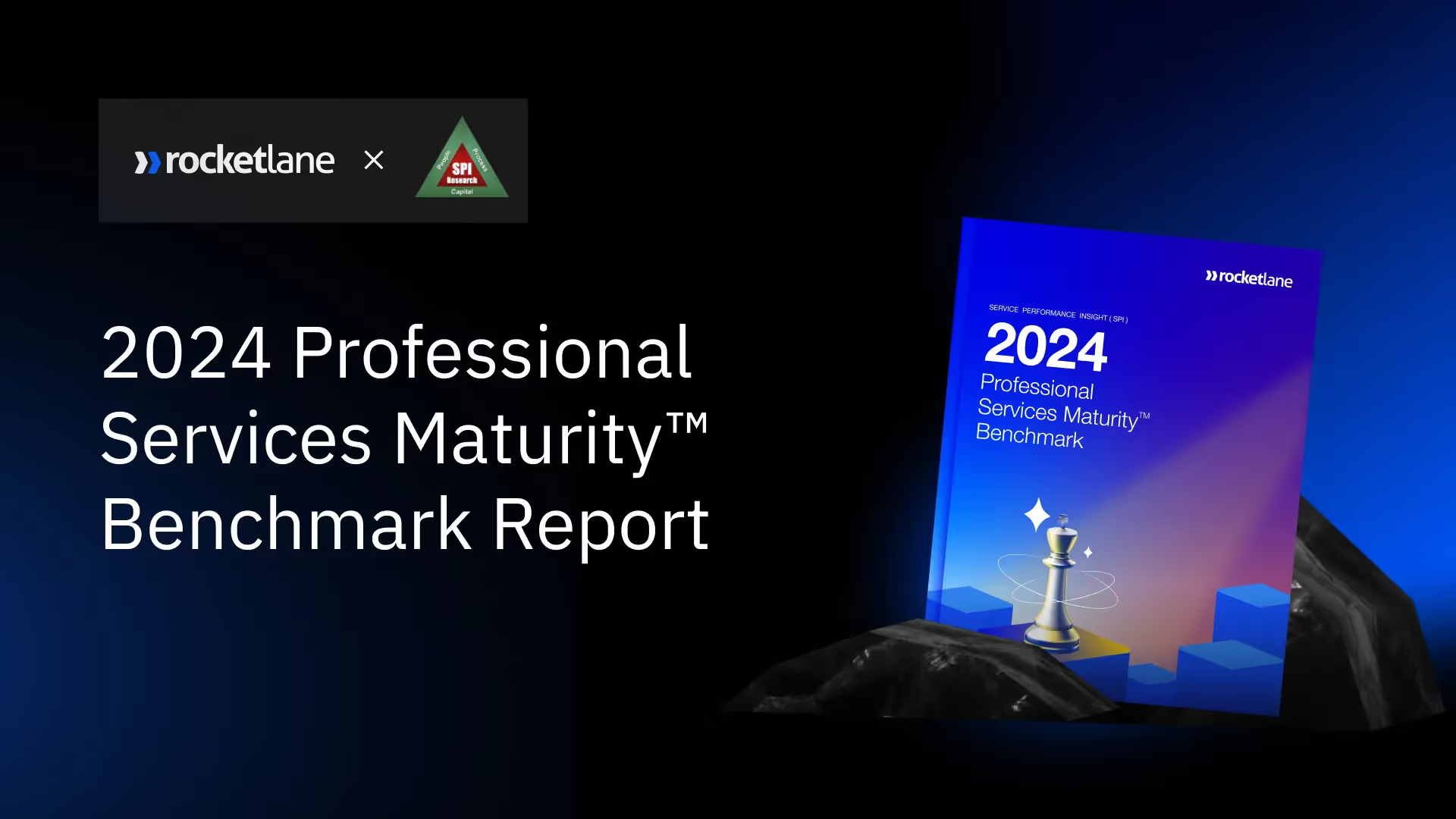Earlier this year, we at Rocketlane collaborated with Service Performance Insight (SPI) to release the 2024 Professional Services Maturity™ Benchmark report. Based on a thorough study of 575 professional services organizations, the report is a valuable tool for professional service firms to stay current on industry trends and gauge their performance.
A significant focus of this year's report was the role of AI in the professional services sector.
To dig deeper into this, we caught up with Dave Hofferberth, Managing Director at SPI, to discuss the profound impact AI is set to have on delivery models within the professional services sector.
The discussion focused on
- The Professional Services Maturity Benchmark
- Challenges in professional services
- How AI is impacting the market
- The role of AI-enabled PSA in improving service delivery
- Recommendations for PS firms
Here are the key takeaways from the session.
About the Professional Services Maturity Benchmark™ model
The Professional Services Maturity Model, developed by SPI seventeen years ago, has since been used by over fifty thousand firms worldwide to understand their performance better, compare themselves to others, and improve their performance capabilities.
The model is based on five pillars (or functional groups): leadership, client relationships, talent, service execution, and finance/operations.
These pillars represent different functional groups within an organization.

The benchmark also includes five levels of service performance or maturity, ranging from Level 1 ( Initiated) to Level 5 (Optimized).
The Professional Services Benchmark survey tracks 155 KPIs, with key ones related to growth and profitability.
Why maturity matters in professional services
It's interesting to note that among the 575 firms surveyed, those at Level 1 experienced losses. This is concerning, especially when you consider that the industry typically expects 10% growth and 15% profitability annually.
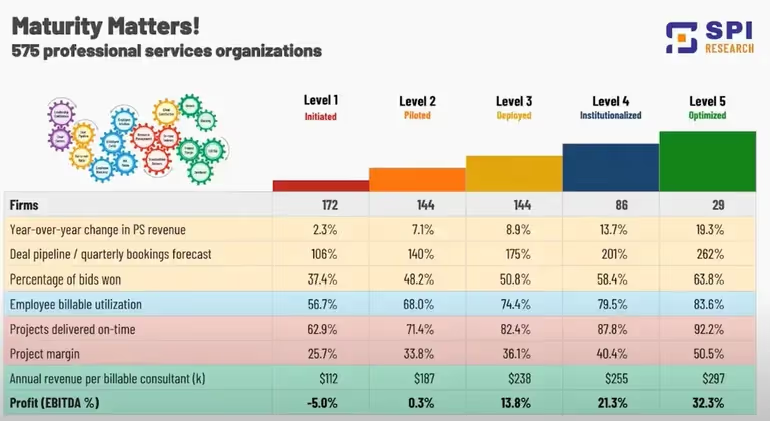
What's clear is that as organizations move up the maturity levels, they tend to see higher growth and profitability. This highlights the importance of advancing maturity in professional services for sustainable success.
Challenges impacting professional services
While professional services excel in delivering services remotely, ensuring client satisfaction, timely delivery, and profitability remains challenging.
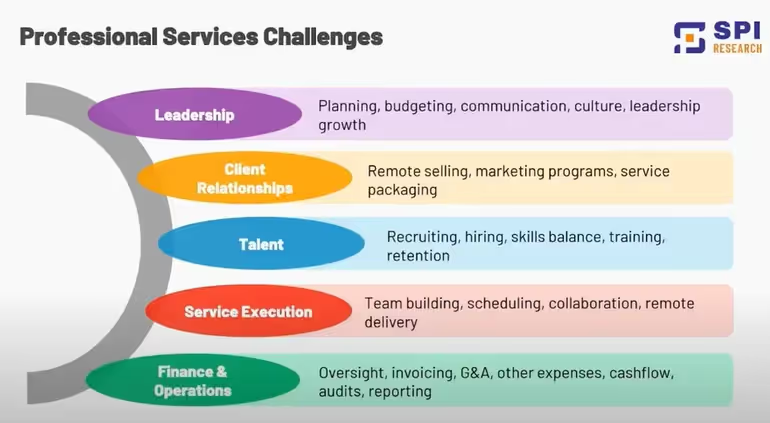
Areas like planning, budgeting, client engagement, and service delivery continue to pose challenges, especially with the added complexities of remote work.
Additionally, it can be challenging for companies to track many KPIs to measure and track performance. The key is to stay focused on the primary goals of professional services, including client satisfaction, organizational profit, employee utilization, and revenue growth.
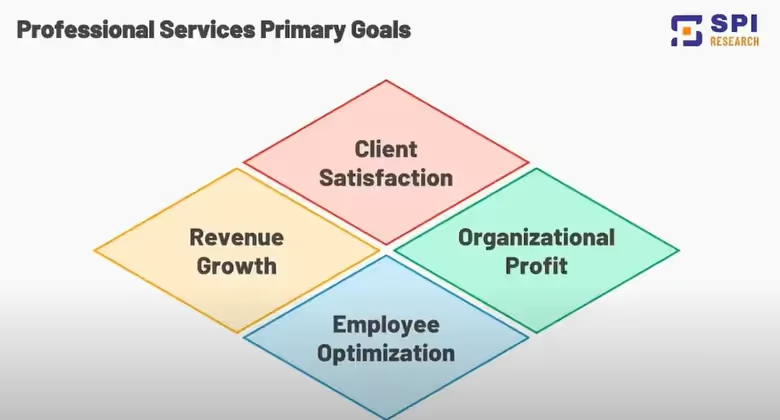
The role of AI in professional services
AI has the potential to transform professional services by enabling more efficient operations, better decision-making, and the development of new products and services. It can help capture and analyze a larger number of KPIs, enabling organizations to gain deeper insights into their performance and make more informed decisions. Additionally, it can help leaders plan more effectively by automating repetitive tasks and providing insights into future trends.
On the talent management front, AI is expected to play a crucial role in talent management for professional services, helping firms hire more efficiently, reduce attrition, and deliver projects with higher quality and margins. Additionally, AI can assist in auditing organizations' performance and improving strategies.
As per the SPI survey, the key areas that AI will drive for PS will be
- Enhanced planning
- New services (and products)
- Greater talent management
- Project process automation
- More efficient audits
The current state of AI usage in PS
The survey highlights a pervasive belief in the importance of AI for both professional services firms and their clients, suggesting significant impacts on future delivery models within the industry.
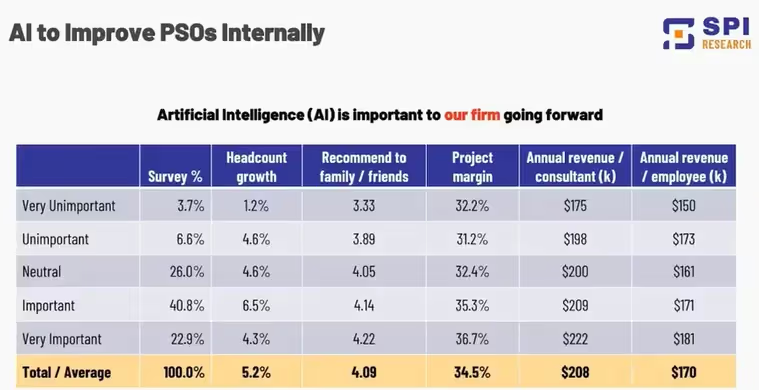
The data speaks for itself: firms embracing AI are experiencing higher revenue growth, increased headcount, and improved efficiency in billable employees and project delivery.
These firms are also more profitable and boast higher revenue compared to their peers.
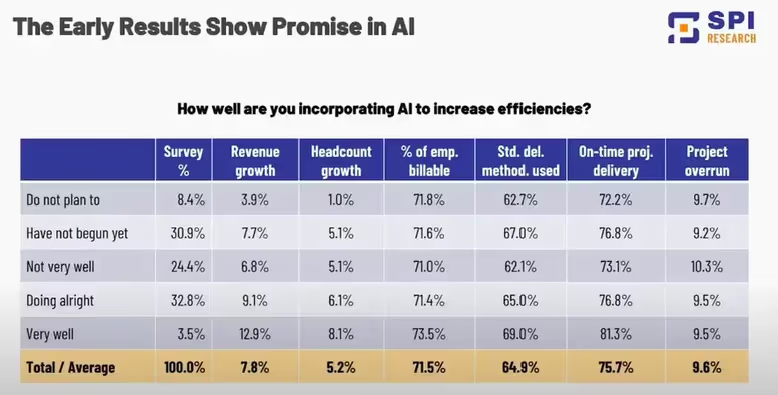
Clients recognize AI's value, with over 60% viewing it as a strategic advantage.
For service providers, AI is an opportunity for growth and profitability. The key is to swiftly embrace its capabilities to tap into this lucrative market and outpace the competition.
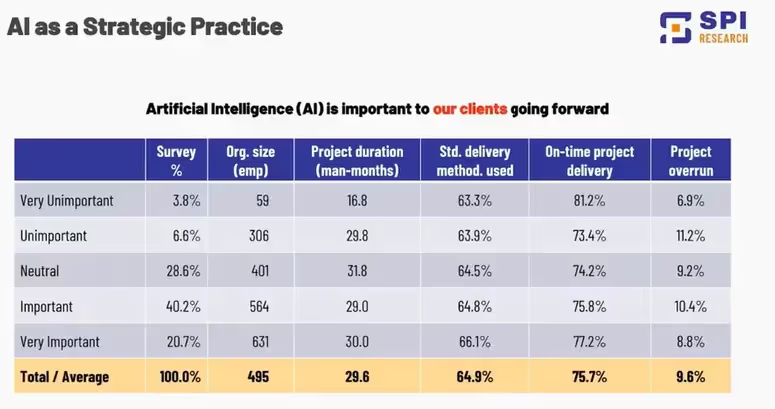
Impact of AI on delivery models
While analysts and popular media often highlight AI's impact on finance and talent management, the SPI survey offers a fresh perspective from the professional services market.
According to respondents, AI's biggest impact will be on service execution. This indicates that AI is valued across all areas of professional services, signaling its potential to revolutionize service delivery.
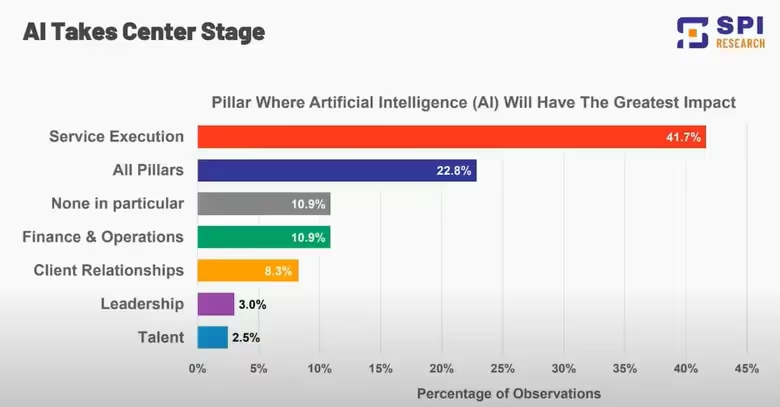
The strong correlation between AI's perceived importance and key performance indicators' improvements underscores larger organizations' belief in AI's transformative power on delivery models and work processes.
Why real-time visibility is critical to drive and improve performance
Gone are the days of quarterly reviews; now, with the help of AI, organizations can have real-time visibility into their performance.
Professional service executives with excellent visibility across their organization see remarkable improvements in key performance indicators, including market share and efficiency, ranging from five to twenty percent.

This highlights the significance of continual enhancement and the critical role of AI in offering the visibility needed for success and expansion.
The impact of Professional Service Automation (PSA) on service delivery
Organizations that fully leverage Professional Services Automation (PSA) solutions tend to experience better revenue growth. This is not directly due to revenue growth itself, but rather the result of improved service delivery efficiency, quality, and timeliness. When services are delivered efficiently and effectively, moving on to the next service becomes easier, leading to higher client satisfaction and increased sales opportunities. This cycle of delivering services well leads to organic growth.
The data shows that organizations using PSA solutions tend to sell bigger projects, as clients have more confidence in their ability to deliver.
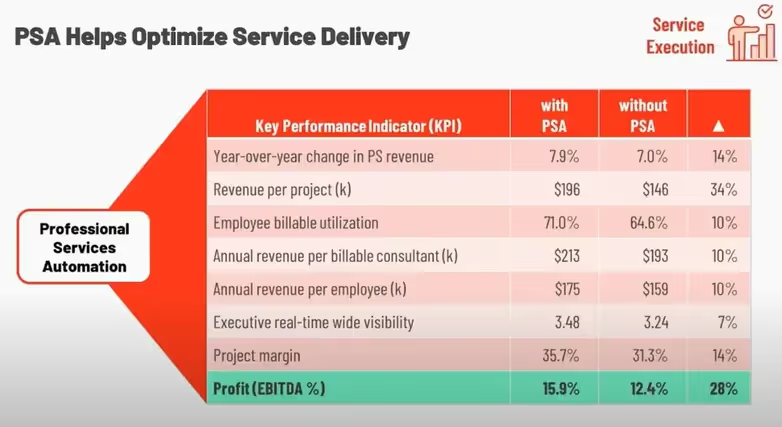
PSA also helps in managing consultant utilization, a key metric in professional services. While senior consultants may only be billable for 20-30% of their time due to other responsibilities, junior consultants may be fully booked and then some.
PSA can add an average of 200 hours or more per consultant per year, translating to significant revenue opportunities. This is reflected in metrics such as annual consultant revenue and employee revenue. Additionally, PSA can improve project margins and overall profitability, key areas for any organization's success.
Leveraging data to assess and improve performance
Organizations are increasingly relying on data to drive their decision-making processes. AI has a huge role to play in this data-driven approach by handling the heavy lifting of data analysis.
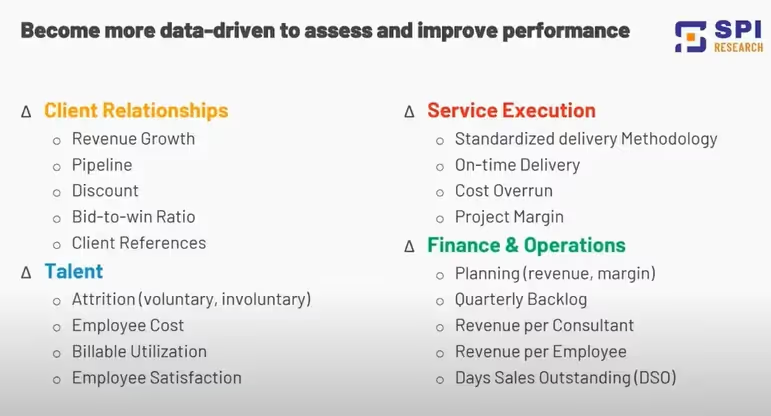
Recommendations for PS firms
1. Leverage AI across key areas
Lean on AI for:
- Improving sales effectiveness and forecasting
- Aligning sales pipelines with resource planning
- Ensuring congruence between sales and service delivery measurements
- Improving service delivery quality and timelines
2. Utilize Data for Planning
Use both backward and forward-looking data to plan service delivery. AI can analyze past project data to identify patterns and trends, helping in better resource allocation and project planning.
3. Use PSA for visibility
Professional Services Automation (PSA) tools can ensure 360-degree visibility into projects, resources, and profitability. Use them to track project progress, resource utilization, and financial metrics, and for valuable insights for decision-making.
Q&A
1. How will AI work across different applications?
AI can work across different applications by leveraging integrations and APIs. PSA tools, like Rocktlane, offer out-of-the-box integrations that consolidate data into one accessible place for AI analysis.
AI can even prompt actions by making API calls to systems it doesn't directly interface with. This means that even if data is spread out, AI can gather context from various sources and provide valuable insights and answers.
2. Will AI change the KPIs companies collect?
While today's tools track a vast amount of data, the key is to identify patterns and derive insights without needing a large team of data analysts. This is where AI can make a significant difference.
With AI, you'll be able to collect and analyze a much broader range of KPIs, some of which you may not have even considered before. Tools like Rocketlane already offer AI-powered solutions that can automatically generate new KPIs. By automating the generation of meaningful KPIs, AI can free up valuable time for professionals, allowing them to focus on strategic decision-making rather than manual data analysis.
3. In what other areas will AI help PSA?
One application is the ability to predict project budget constraints before they reach critical levels, enabling proactive decision-making. Another promising area is in analyzing customer interactions and support ticket data to improve customer satisfaction.
Organizations can enhance their service delivery and client relationships by leveraging AI to identify patterns and insights from various data sources.
4. What is the role of AI assistance in PS?
AI assistance can play a crucial role in enhancing project management and efficiency. These AI assistants can help achieve specific project objectives, monitor key project areas, and optimize resources and time. One exciting aspect is their ability to track changes and assess their impact on project plans, allowing for proactive adjustments. For example, AI assistants can identify revenue leakage by analyzing data that organizations already have but may not have utilized effectively.
How Rocketlane tackles the data silos problem to take your service delivery to the next level
The biggest challenge companies face today arises from the multitude of tools used across project and professional services management. Teams employ separate tools for time tracking, resource management, and business intelligence, creating fragmentation. This disjointed approach results in disconnected project and professional services tools, making it difficult to derive actionable, real-time insights from the system.
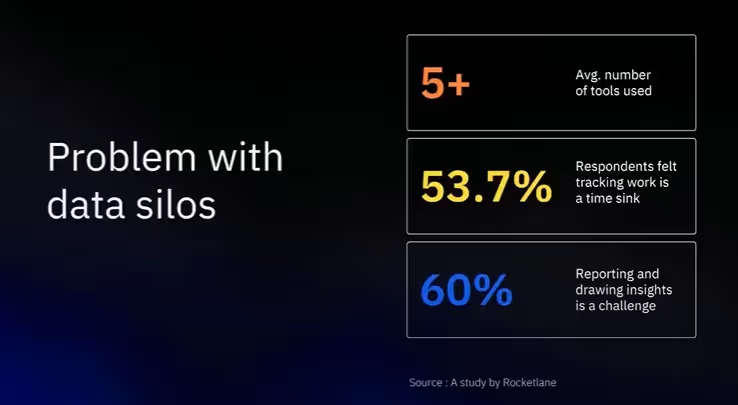
That’s where Rocketlane comes in.
Rocketlane can transform your service delivery by offering robust support for long-term capacity planning and professional sales estimation processes. Through tight integration with your CRM, it not only tracks ongoing projects but also provides visibility into your pipeline and upcoming projects.
One of its standout features is its resource management capabilities.
Traditionally, project managers face a cumbersome process of manually estimating resource needs, checking availability, and coordinating with resource management teams using spreadsheets or disparate tools.
By analyzing your team's capacity and requirements, Rocketlane generates a demand-supply equation, offering insights through capacity planning reports. These reports present a heat map of different roles based on ongoing and upcoming projects, highlighting potential bottlenecks or skill shortages.
Rocketlane’s Resource AI leverages two powerful features, Load Balance, and Maximizing Margin, to quickly assemble the optimal project team. Load Balance ensures equitable distribution of workload, minimizing underutilization or overburdening of team members. On the other hand, Maximizing Margin focuses on maximizing the overall profit margin of the project, considering factors such as resource cost and project budget.
There’s a lot more Rocketlane can do for your PS teams. Talk to our team to know more.


